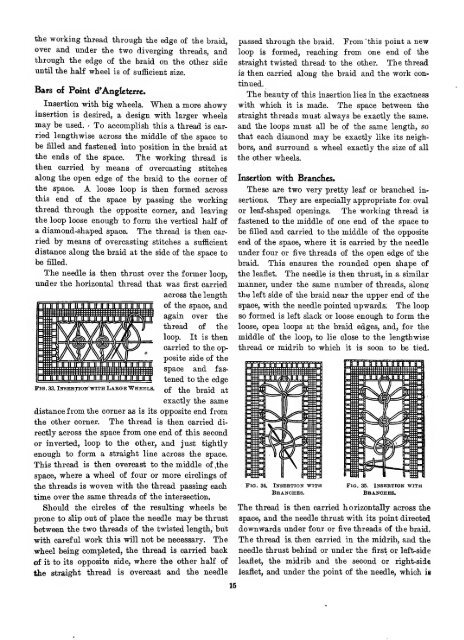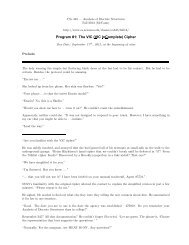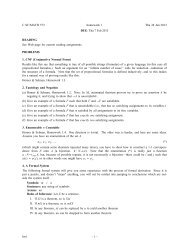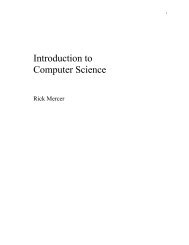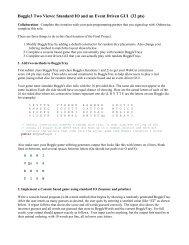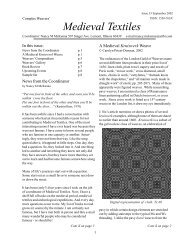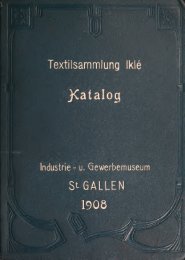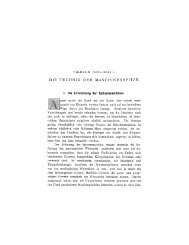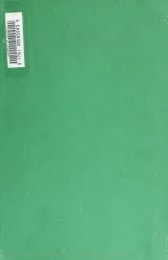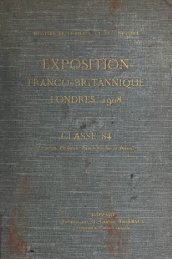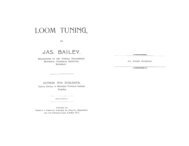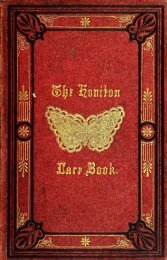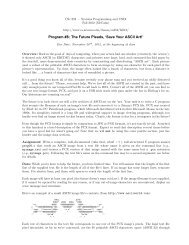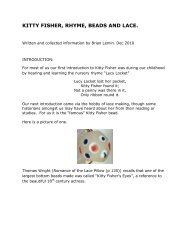The Priscilla Battenberg and point lace book; a collection of lace ...
The Priscilla Battenberg and point lace book; a collection of lace ...
The Priscilla Battenberg and point lace book; a collection of lace ...
Create successful ePaper yourself
Turn your PDF publications into a flip-book with our unique Google optimized e-Paper software.
the working thread through the edge <strong>of</strong> the braid,<br />
over <strong>and</strong> under the two diverging threads, <strong>and</strong><br />
through the edge <strong>of</strong> the braid on the other side<br />
until the half wheel is <strong>of</strong> sufficient size.<br />
Bars <strong>of</strong> Point d'Angleterre.<br />
Insertion with big wheels. When a more showy-<br />
insertion is desired, a design with larger wheels<br />
may be used. ' To accomplish this a thread is car-<br />
ried lengthwise across the middle <strong>of</strong> the space to<br />
be filled <strong>and</strong> fastened into position in the braid at<br />
the ends <strong>of</strong> the space. <strong>The</strong> working thread is<br />
then carried by means <strong>of</strong> overcasting stitches<br />
along the open edge <strong>of</strong> the braid to the corner <strong>of</strong><br />
the space. A loose loop is then formed across<br />
this end <strong>of</strong> the space by passing the working<br />
thread through the opposite corner, <strong>and</strong> leaving<br />
the loop loose enough to form the vertical half <strong>of</strong><br />
a diamond-shaped space. <strong>The</strong> thread is then car-<br />
ried by means <strong>of</strong> overcasting stitches a sufficient<br />
distance along the braid at the side <strong>of</strong> the space to<br />
be fiUed.<br />
<strong>The</strong> needle is then thrust over the former loop,<br />
under the horizontal thread that was first carried<br />
across the length<br />
II 11 II II II II II II II II If II II II II II II II <strong>of</strong> the space, <strong>and</strong><br />
lllMIBiaiapniBIBIBIBI'fl'lifilBI<br />
again over the<br />
thread <strong>of</strong> the<br />
loop. It is then<br />
carried to the op-<br />
posite side <strong>of</strong> the<br />
space <strong>and</strong> fas-<br />
tened to the edge<br />
Fig. 33. iNSEBTioir WITH Large Wheels.<br />
<strong>of</strong> the braid at<br />
exactly the same<br />
distance from the corner as is its opposite end from<br />
the other corner. <strong>The</strong> thread is then carried di-<br />
rectly across the space from one end <strong>of</strong> this second<br />
or inverted, loop to the other, <strong>and</strong> just tightly<br />
enough to form a straight line across the space.<br />
This thread is then overcast to the middle <strong>of</strong> ,the<br />
space, where a wheel <strong>of</strong> four or more circlings <strong>of</strong><br />
the threads is woven with the thread passing each<br />
time over the same threads <strong>of</strong> the intersection.<br />
Should the circles <strong>of</strong> the resulting wheels be<br />
prone to slip out <strong>of</strong> p<strong>lace</strong> the needle may be thrust<br />
between the two threads <strong>of</strong> the twisted length,' but<br />
with careful work this will not be necessary. <strong>The</strong><br />
wheel being completed, the thread is carried back<br />
<strong>of</strong> it to its opposite side, where the other half <strong>of</strong><br />
the straight thread is overcast <strong>and</strong> the needle<br />
passed through the braid. From 'this <strong>point</strong> a new<br />
loop is formed, reaching from one end <strong>of</strong> the<br />
straight twisted thread to the other. <strong>The</strong> thread<br />
is then carried along the braid <strong>and</strong> the work con-<br />
tinued.<br />
<strong>The</strong> beauty <strong>of</strong> this insertion lies in the exactness<br />
with which it is made. <strong>The</strong> space between the<br />
straight threads must always be exactly the same,<br />
<strong>and</strong> the loops must all be <strong>of</strong> the same, length, so<br />
that each diamond may be exactly like its neighbors,<br />
<strong>and</strong> surround a wheel exactly the size <strong>of</strong> aU<br />
the other wheels.<br />
Insertion with Branches.<br />
<strong>The</strong>se are two very pretty leaf or branched in-<br />
sertions. <strong>The</strong>y are especially appropriate for. oval<br />
or leaf-shaped openings. <strong>The</strong> working thread is<br />
fastened to the middle <strong>of</strong> one end <strong>of</strong> the space to<br />
be filled <strong>and</strong> carried to the middle <strong>of</strong> the opposite<br />
end <strong>of</strong> the space, where it is carried by the needle<br />
under four or five threads <strong>of</strong> the open edge <strong>of</strong> the<br />
braid. This ensures the rounded open shape <strong>of</strong><br />
the leaflet. <strong>The</strong> needle is then thrust, in a similar<br />
manner, under the same number <strong>of</strong> threads, alons;<br />
the left side <strong>of</strong> the braid near the upper end <strong>of</strong> the<br />
space, with the needle <strong>point</strong>ed upwards; <strong>The</strong> loop<br />
so formed is left slack or loose enough to form the<br />
loose, open loops at the braid edges, <strong>and</strong>, for the<br />
middle <strong>of</strong> the loop, to lie close to the lengthwise<br />
:,,_<br />
thread or midrib to which it is soon to be tied.


